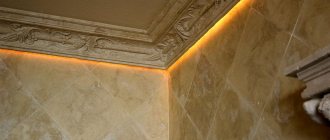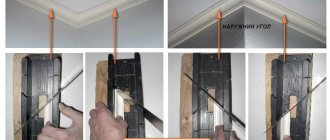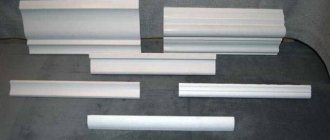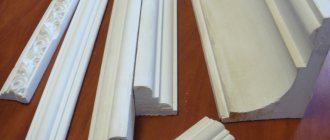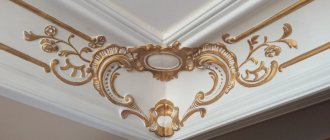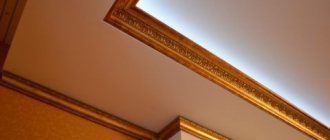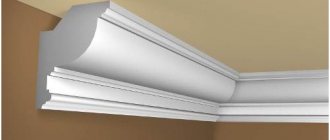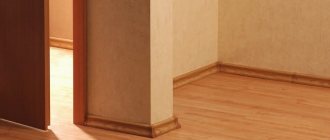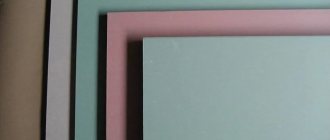Standard length and width of the plinth and its calculation
It is difficult to imagine modern renovations without the use of skirting boards.
Floor and ceiling shaped profiles not only cover joints and hide minor defects, but also complement the interior, giving it a finished look and neatness. And if previously there were 2-3 standard models on sale, today it is already very difficult to choose the right floor and ceiling plinth from all the variety. The sizes, shapes, and color palette are so diverse that you need to know at least the basic parameters.
In the article we will talk about the typical sizes of floor and ceiling planks, how wide a plinth can be, what is the length of the strips, and how to calculate the amount of plinth.
Typical sizes
Before drawing a design project for a room, and at least imagining in your mind how the baseboard will look in the interior, you just need to know what standard dimensions for the width and height of the profile are on sale.
High plinth combined from different materials
Plastic and MDF laminated
The most popular in modern budget renovations are plastic floor skirting boards; they can be considered universal, since thanks to the huge selection of sizes, colors and textures, moldings can be matched to almost any floor covering. Most often, MDF profiles are used for laminate flooring, and plastic ones are used for bathtubs, as they are not afraid of moisture.
The standard length of PVC plinth is 2.5 m. But in the cross section, the profile dimensions have undergone a major transformation. The width of the floor plinth along the lower leg is from 15 to 23 mm. The height of the bar can reach 150 mm. In standard apartments with a ceiling of 2.7 m, plastic floor plinths are most often installed, the dimensions of which range from 55 to 65 mm in height and 23 mm in width; as a rule, these are planks with a built-in cable channel.
The most popular sizes of plastic skirting boards for floors
Wooden and veneered models
Wooden models are an unchanging tradition and always a refined look for the interior. And it should be noted that the woodworking industry is trying to keep up with the times, and is no longer limited to the manufacture of fillets with a triangle in cross-section. Today, the market offers a large selection of wide and narrow shaped wooden profiles, the standard lengths of which are 210, 230, 250 and 300 cm. The height and width of the wooden planks is determined by the average size of a typical home. Wide wooden models according to European standards are also produced. The materials and shape largely depend on the manufacturer, but consumer demand coupled with competition sets the standard dimensions for the height and width of the slats.
Wooden plinth, sizes and shape of typical models
Polyurethane, foam, polystyrene
Skirting boards made from modern foam polymer materials have the widest range of shapes, decor and width of the strips. The only thing that can be said with certainty is that with different widths the length of the whip is 2 m.
Attention: As a rule, skirting boards made of polyurethane, foam plastic and polystyrene are used to decorate the joints between the ceiling and the wall, but the polyurethane profile, due to its chemical and physical characteristics, is also in demand for finishing the joints between the floor and the wall.
The narrowest plinth of these materials has a cross-section of 15*10 mm; this model is used if it is necessary to close the joint so that the profile is almost invisible in the interior. More often, for modern renovations, the width and height of the plinth are selected based on the dimensions of the room. The table shows the popular standard sizes of ceiling plinths:
| Room height, m | 3,0 | 2,7 | 2,5 |
| Area, m2 | Width of ceiling plinth, mm | ||
| 25 | 180 and above | Up to 150 | 80 |
| 20 | 150 | 120 | 50-80 |
| 16 | 150 | 100 | 40-60 |
| 12 | 120 | 60-80 | 30-50 |
As for the polyurethane floor plinth, its height and width are identical to their wooden and plastic counterparts, but if necessary, you can increase the size using decorative molding.
Width and height of ceiling fillets made of polystyrene and polyurethane
Other options
In addition to those described above, profiles made of specific materials are now in demand for finishing. So for tiles, the best option is a ceramic plinth; the width of such a border can vary from 2.5 to 10 cm. For plastic countertops, it is advisable to use a PVC profile with a width of 3.0 cm. For stone work surfaces, the standard plinth height is 3.0-5.0 cm, although if necessary it can be cast or cut to any size.
Skirting parameters
How to choose the correct size of parts? Almost all fillets have the same length - two meters. Width from 1 to 20 cm. Please consider this parameter carefully. The selected wide baseboard smooths out the corners. The room looks more rounded and calm.
This decor hides defects in the joints of the ceiling and walls.
Too wide fillets visually make the room lower. The optimal decor width in a standard room is approximately 35 mm. If the ceiling height is more than 3 m, use a 50-60 mm plinth.
How to choose a ceiling plinth: types and sizes of fillets
Ceiling plinth completes the design of the ceiling, decorates the room, emphasizes style and helps hide minor imperfections. This decorative element also has many other names: molding, fillet, baguette, frieze, interior cornice. In addition, there is a huge variety of different models on sale. In this article we will tell you how to choose the right ceiling plinth, taking into account the characteristics of the room. Let's look at what fillets are made of, the advantages and disadvantages of each material, as well as the available options for width and texture.
What materials are ceiling plinths made from?
Let's take a closer look at the most popular options. Some of them are modern developments, others relate to traditional, familiar materials.
Styrofoam
This option is popular in budget renovations. Foam plinth is made from polystyrene by stamping.
The following advantages are noted:
- low cost (one of the cheapest materials on the market);
- low weight, facilitating repairs: easy to deliver and install alone (foam plinth is a leader in this indicator);
- many design options - suitable for different styles and sizes of rooms;
- the ability to paint in any color;
- During installation there is no need for specialized tools; it is easy to cut with a stationery knife.
But there are also disadvantages:
- turns yellow over time, it is better to paint;
- fragile, easy to accidentally scratch or push through;
- burn, fire hazard;
- Not all compounds can be glued - many corrode the foam;
- do not tolerate moisture, cannot be used in the bathroom or kitchen without painting;
- it is impossible to get a clear picture;
- You have to trim the uneven edges before installation.
Polystyrene
This material is similar to the previous one, but thanks to other production methods it is stronger. There are the following types of polystyrene ceiling plinths:
- injection;
- extruded;
- laminated.
Color selection
Stores sell ready-made skirting boards in different shades and white ones intended for painting. In the second case, you can choose any shade and paint it, which is not difficult. But before choosing, you need to familiarize yourself with the basic recommendations:
- If the walls and ceiling are painted the same color, the baseboard should stand out against their background, otherwise the surfaces will merge. A white plinth or any other will do, which will look contrasting with the walls and match them, match the style and be present in the interior;
Related article: Fence for a summer residence: what material to choose in 2019?
- For rooms with low ceilings, it is recommended to use baseboards that match the walls to raise them a little. In this case, the color of the ceiling should be lighter, otherwise the opposite effect will occur;
- In a room with a small area, skirting boards are selected identical to the ceiling so that they merge as much as possible. As a result, the room will expand a little, because there will be no boundaries on the ceiling and at the same time it will be completed;
- It's difficult to choose a color, choose white. It is ideal for all rooms decorated in different shades and styles. Any subsequent layer when repainting fits equally well on it;
- The contrasting color looks vibrant and original. The plinth immediately catches the eye and clearly demarcates the surfaces, highlighting strict lines. In this case, you need to be extremely careful when choosing a tone in order to achieve a positive result.
Standard plank sizes
Typical size of wooden edging decor
The standard is a wooden plinth, the dimensions of which are 40 * 22 * 2500 mm. It is usually used in low, small rooms when performing budget renovations. For spacious apartments, you can choose a slightly higher decor from 60 mm. The width of the baseboard for non-standard flooring varies from 15 to 25 mm.
A very convenient flat wooden edging decor is also available in terms of saving space. The width of its base is usually 16 mm, and the height can vary from 80 mm to 120 mm. There is also a 300 mm high plinth on sale.
Tip: For very small rooms it is best to use a narrow version from 30 mm to 35 mm. If the store does not have such a model, you can order it from the workshop.
The most commonly used wooden floor skirting boards. Standard dimensions - 22*40 mm
Standard size of PVC planks
Plastic edging decor does not have such a variety of sizes as wooden ones. However, this type of plank can be either standard or non-standard. Plastic floor plinth, the dimensions of which are 51*21*2500 mm, is used most often and is considered standard. Typically this option comes with a cable channel.
Planks with a height of 5 cm to 6.5 cm are also very common. The length of PVC skirting boards is sometimes 2000 mm.
Standard PVC plinth. Its dimensions are 21*51 mm
Dimensions of ceramic planks
Ceramic baseboards for a bathroom or kitchen, as well as countertop strips made of natural or artificial stone, usually have the same length as the tiles or stone tiles themselves. The height of a ceramic skirting board can be different and depends on the specific type of tile.
The size of the ceramic strips matches the size of the tile itself
Polyurethane option
Since polyurethane floor decor can have a wide variety of designs, there are no standard sizes. The width of the planks ranges from 10mm to 3 cm. The standard length is 2500 mm. As for flat planks, in interiors you can most often see decor with a height of 70 mm-150 mm. The width of the polyurethane ceiling plinth is usually the same.
Note: The standard length of the ceiling fillet is 2 m. But if you wish, you can also find options 2600-2700mm. This type of plinth is faster to install.
Polyurethane strips can have a variety of sizes
Dimensions of foam fillets
Ceiling foam and polystyrene foam baguette can also have a variety of sizes. The length of the standard version is 2 m. The smallest baguette can have a height of only 15 millimeters. Wide ceiling plinths (up to 130 mm) are also available. The thickness of such planks is usually 15-85 mm. For a large room, you can also purchase a thick 100 mm baguette.
Foam ceiling plinth, the dimensions of which (width and thickness) can be very different, has a standard length of 2 m
Calculation of planks
How to calculate the consumption of slats? In order to find out the required number, you should measure the room around the perimeter. To the resulting figure we add another 2 m for reserve. Since the usual dimensions of a plastic floor plinth are 2.5 m, in this case we divide the final result by 2.5. The standard length of a ceiling fillet is 2 m. Therefore, when calculating the required number of planks, we divide the perimeter of the room by 2.
To perform a more accurate calculation of the material, it is worth drawing a room plan
For a wall with one doorway, you will have to buy two end elements. Calculating how many connecting elements are needed is also easy. For a wall 2.5 m long, a connector is not needed. For a 5 m wall you will need 1 and so on.
How to choose a plinth for the ceiling
Not all apartment owners pay attention to renovations, during which the plinth for the ceiling is of great importance. It highlights the design of the room. This part is also called a fillet. They are designed to hide the junction of the walls and the ceiling, which prevent the room from acquiring a finished look. Therefore, choosing a fillet is an important matter in preparing and carrying out repairs.
Ceiling plinth: sizes, colors, types
In most cases, ceilings after cosmetic or major renovation of a room are framed with baseboards. This not only allows you to decoratively separate this plane of the room from the rest, but also emphasizes its individuality and a certain style of the room. And correctly selected baguettes add volume to the space.
From this article you will learn about the varieties of these products, how to choose a ceiling plinth to complete your interior design, and our gallery will demonstrate examples of successful room decoration using baguettes.
Types of ceiling plinths
The main criterion by which the classification of ceiling moldings is carried out is the material of their manufacture. These products can be:
- from foam plastic;
- polystyrene foam;
- semi-urethane;
- from PVC (polyvinyl chloride);
- plaster;
- wooden.
Each of these types has certain technical characteristics and creates different ways to decorate the surface.
Foam ceiling plinth
If you want to carry out repairs at minimal cost, then pay attention to foam products. The material is affordable, can be easily cut to the required size, and comes in various configurations (can imitate stucco). But its main disadvantages are flammability and low strength.
Most often, this plinth is used for finishing suspended structures mounted from plasterboard, as well as various false ceilings. It is installed during the process of starting to putty the room (using the same solution).
Foam ceiling plinth lends itself perfectly to painting
Polystyrene baguette
Polystyrene or extruded polystyrene foam is an analogue of polystyrene foam, only this material is more durable and does not ignite. The cost is slightly higher than polystyrene foam, but belongs to the average price category.
Ceiling plinth made of polystyrene can be used on both plaster and plastic finishes. Expanded polystyrene baguettes are attached to special glue or gypsum mortar (depending on the surface finishing material).
Decorating the premises with polystyrene foam ceiling plinths
Products made of polyurethane
Those who cannot afford expensive plaster molding can replace it with polyurethane (PPU) baguettes. These products are very flexible, capable of taking on various shapes, framing figured ceilings and columns.
Most often, polyurethane ceiling plinth is used to decorate plastic surfaces, as well as PVC lining. It is attached using special glue.
Polyurethane foam products are ideal for decorating semicircular surfaces
PVC ceiling plinth
Plastic products (polyvinyl chloride) for ceiling decoration are most often used along with homogeneous PVC lining. The plastic ceiling plinth not only serves as decoration, but also serves as a profile into which the lining is inserted.
Plastic ceiling plinth, photo
These baguettes are very flexible, and the variety of colors allows you to match them to any type of ceiling decoration. They also contain decorative elements - gilding, holographic inserts.
PVC ceiling plinth with gold edging around the edges and a hologram
Gypsum fillets
Products made from gypsum are traditionally characteristic of the classic style of interior design. Gypsum moldings have been used for room decoration for a long time and today they are used to frame figured moldings, as an artistic element in the overall decorative composition. Ceiling plinths made of gypsum can be of different sizes, have different patterns, and you can paint them yourself. They are attached using putty or alabaster.
Among the advantages of gypsum products are their environmental friendliness, high quality, individuality, and durability. Disadvantages include significant weight, fragility, and high cost.
Exquisite bronzed gypsum ceiling plinth in the interior
Wood products for ceiling decoration
Wooden ceiling also belongs to the classic decorative elements. It is mainly used for framing floors, but for ceilings such a fillet is appropriate only when there are other wooden elements in the room.
Wood in the interior is a sign of aristocracy. This eco-friendly material is strong and durable. Disadvantages of wooden skirting boards: difficulty in processing, susceptibility to rotting, mold, drying out. There may also be bugs in the tree.
Advice: before installing wooden fillets, they should be pre-treated with an antiseptic and coated with a protective varnish. This will extend their service life.
According to the price category, wood products can be divided into two groups: expensive ones made from valuable species (oak, cherry), and an economical option (made from pine, spruce). Wooden ceiling plinths are attached using screws, as well as metal and wooden nails.
A wooden ceiling plinth will be appropriate in a classic design style along with other wood elements
How to glue ceiling plinth to wallpaper: development and features
After selecting the ceiling plinth, the installation process begins. When answering the question of what wallpaper or ceiling plinth comes first, proceed from the highlights of the room. If you glue the ceiling plinth to the wallpaper, then under such conditions it is sufficient to use glue or putty. Please note that installing the baseboard with glue is only possible in this case, when it is made of plastic or polyurethane foam.
This method of installing skirting boards is simple and quick to perform, which is why it is widely used when performing repairs.
If you plan to glue the ceiling plinth first, and then the wallpaper, then in this case you will need to be patient. Installation of skirting boards in this way is carried out only by specialists who have experience in wallpapering and installing skirting boards. Under such criteria, first, all the cracks in the baseboard are sealed, and then the wallpaper is glued.
To install the ceiling plinth you will need:
- Glue having a polymer base;
- Glue moment of installation;
- Putty, which is mixed on an adhesive base.
It is better to use materials during installation of the plinth that are recommended by the manufacturer in the instructions for the plinth. Under such criteria, it will be possible to achieve enormous adhesion of the baseboard to the surface of the ceiling and wall.
During the work process you will need:
- Stationery knife;
- Hacksaws;
- Spatula;
- Roulettes;
- Brush;
- Pencils;
- Adhesive composition;
- Paint;
- Sandpaper;
- Sealant with a dull base.
Later, the procedure for determining the number of skirting boards to be installed in the room will be carried out. To do this, it is enough to find out the perimeter of the ceiling and, in relation to it, find out the number of baseboards. Receive the material with supplies so that if damaged, you can replace the warped area.
Preparation for installation of skirting boards is as follows:
- Take a cardboard sheet and a pen, draw the ceiling to a certain scale;
- First, establish on the project the installation locations for whole skirting boards, and then place the cut skirting boards;
- Choose the side for laying the plinth, keep in mind that one side of the profile is always wider than the other.
The wide side is used to hide imperfections from wallpapering, if any.
Note on installing skirting boards:
1. Trim the corner sections of the skirting boards in accordance with the markings. To do this, use a special tool in the form of a miter box. A plinth is installed in it, and the work is carried out with a hacksaw or a stationery knife. Cut the baseboard in relation to the angle marked earlier.
2. Please note that special attention should be paid to cutting the plinth at an angle, since for protruding corners and for corners in rooms, plinths are cut in different ways.
3. Glue is applied to two longitudinal hollows of the plinth. Please note that it should not extend beyond the surface of the outer edges. If there is glue on the outside of the baseboard, prepare a dry rag to remove it.
4. Install the plinth on the wall and hold it for a certain time indicated in the annotation to it. Press the baseboard lightly as there is a risk of damaging it.
5. Glue all other parts of the plinth in the same way. To seal cracks, use a sealant matched to the color of the baseboard.
6. After the sealant has dried, the baseboard is painted in the desired color.
7. To avoid staining the wallpaper with paint, the baseboards are painted before wallpapering. Otherwise, carry out all work with extreme caution.
